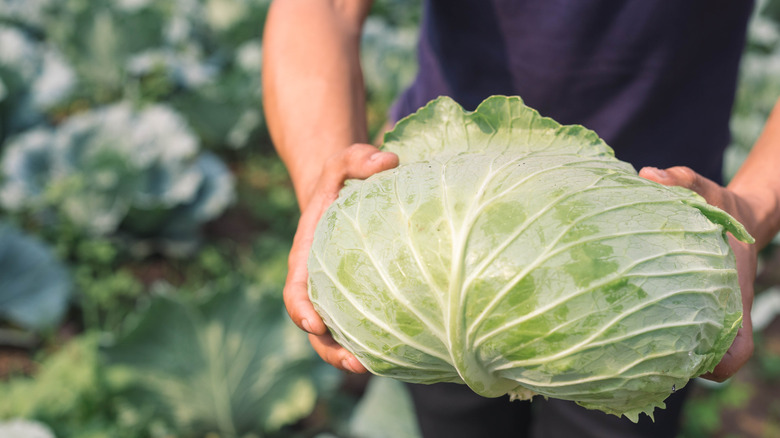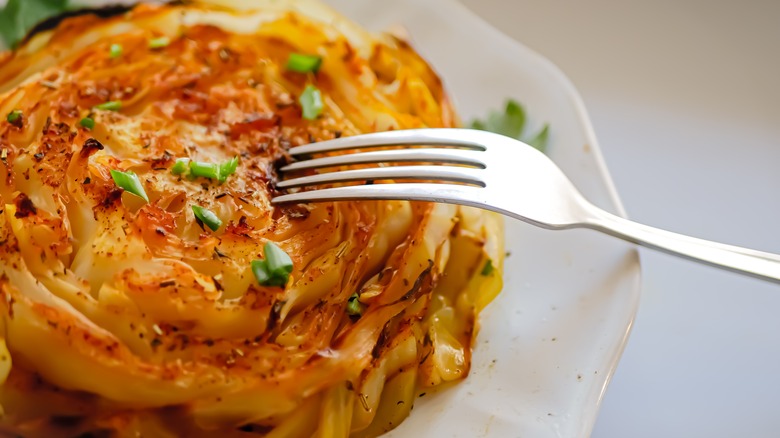Tom Colicchio's Apple Cider Trick To Give Cabbage A Tangy Edge
Cabbage isn't exactly poised to win any produce popularity contests. In the United States, at least, most people only embrace it as a summertime side dish (coleslaw) or perhaps a hot dog condiment in the form of sauerkraut. Is it the sheer size of a cabbage and the work it takes to break one down? Is it the cloying, house-permeating smell it exudes when cooking, or its disappointing tendency to become pale and mushy? (Don't worry, we'll help with that later.)
The truth is, cabbage is grown in nearly a hundred countries. It was first cultivated in Europe and has since spread throughout the world, where it's beloved in dishes such as kimchi, stuffed cabbage, corned beef and cabbage, and soups.
Cabbage is also extremely healthful — it's high in vitamin B6 and C, folate, fiber, polyphenols, antioxidants, and sulfur compounds (which contribute to its telltale odor). But if you're hesitant to welcome it into your kitchen, there's an easy way to make it taste restaurant-worthy.
Apple cider or apple cider vinegar?
In his Food & Wine book "Dinner Special: 150+ Recipes for a Great Meal Any Night of the Week," chef Tom Colicchio shares a simple recipe for apple cider-braised cabbage that also calls for apple cider vinegar. Food & Wine explains that the acidic additions lend a sweet, sharp flavor to the cabbage. This is similar to the Southern American tradition of adding vinegar to the pan when cooking a related vegetable, collard greens, with pork — it helps harmonize the rich, meaty flavors of the dish.
The vinegar tames the greens' bitterness and adds a tart dimension to the aptly-named "pot likker" broth that forms when you cook them down. Because raw cabbage can be tough, crunchy, and dense, the acid in apple cider or apple cider vinegar also assists in making it softer.
Interestingly, vinegar will also keep red cabbage from turning an alarming (but totally harmless) blue color during cooking. While apple cider is seasonal and perishable, apple cider vinegar is a long-lasting, year-round pantry staple — and it only takes a capful to see cabbage results.
More cabbage cooking hacks
Cabbage and apple is a wonderful combination. You can make warm cabbage, apple, and wheat germ salad for a hearty wintertime dish. There are plenty of baked salad recipes that can elevate your cabbage (and other brassicas, and cold-season veggies) into entrée status. Just be sure to use a brief, hot cooking method to retain crunch, or use a little baking soda to keep your cabbage green and un-soggy.
In the absence of apple cider or apple cider vinegar, you can reach for other acidic seasonings to achieve similar results. Consider using red wine or red wine vinegar, as Tom Colicchio does in his roast porcelet with sausage and apples recipe. You can also use tangy tomatoes, as in Polish sweet cabbage, rice vinegar as demonstrated in this cabbage and chili crisp stir-fry recipe, or white vinegar and lemon juice in sweet and sour stuffed cabbage.
The next time you wind up with a dirt-cheap, gigantic head of cabbage, know that all that stands between you and several delicious meals is a little knife work and a bit of culinary acid.


